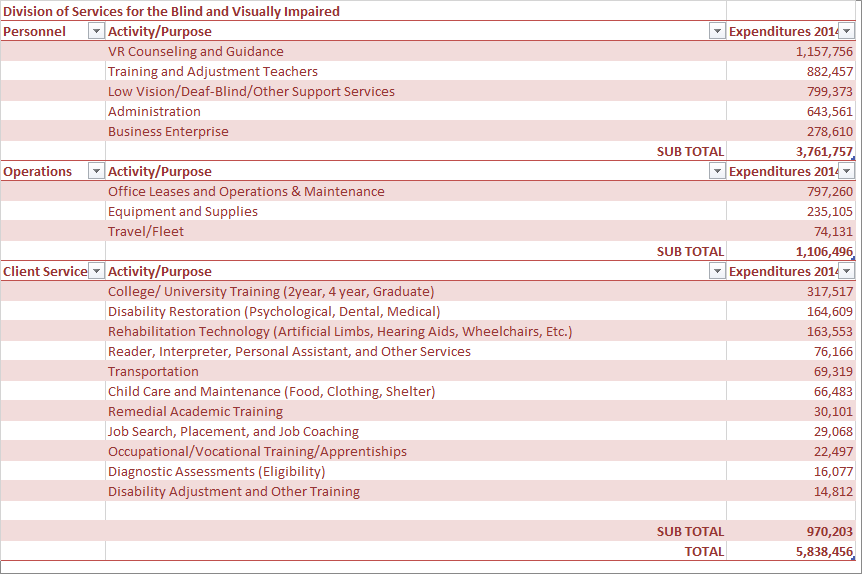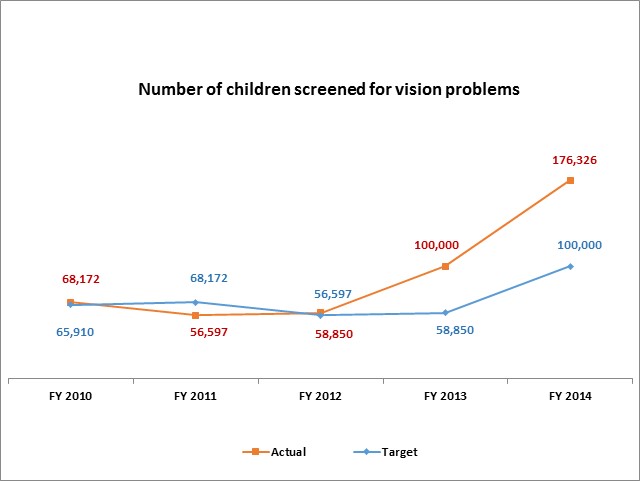The Division of Services for the Blind and Visually Impaired (DSBVI) assists individuals who are blind or visually disabled to obtain employment and increase their independence. The division provides a variety of services that include orientation and mobility assistance, clinical vocational rehabilitation counseling, training, adaptive technology services, adjustment to blindness training activities, visual screening of children, and prevention of blindness training. The division also administers a Business Enterprise Program that includes cafeterias, gift shops, and convenience stores and vending routes in various government locations. These businesses are operated by blind vendors under the program's guidelines.
During the 2015 General Session, the Legislature appropriated for Fiscal Year 2016, $6,314,400 from all sources for Blind and Visually Impaired. This is an 8.4 percent increase from Fiscal Year 2015 revised estimated amounts from all sources. The total includes $2,678,500 from the General/Education Funds, an increase of 21.6 percent from revised Fiscal Year 2015 estimates.
In addition to statewide compensation and internal service fund cost increases, the following appropriation adjustments were made during the 2015 General Session:
For the most recent completed fiscal year, the following information represents the purposes for which the money was used:



Regarding the positive trend greater than 5% in the number of children screened for vision problems from the Services for Blind and Visually Impaired program performance measures, the agency states, " The increase in this measure is resultant of multiple factors. The division has made effort to have better communication with school health nurses, communications with Charter Schools has resulted in their becoming very involved, and that screening is now done to students through the 3rd grade. Over 178,000 children from age 3 through age 8 were screened this past year."
Regarding the positive trend greater than 5% in the number of individuals provided low vision services from the Services for Blind and Visually Impaired program performance measures, the agency states, " Low vision staff have conducted strategic outreach to medical centers, clinics, eye care professionals, etc. which has increased the number of individuals served through this portion of the division. The items provided include low vision devices, canes, Braille and large print devices."
The DSBVI provides pre-school vision screening. According to state law, DSBVI coordinates vision screening for children pre-school through age 8 throughout Utah. Several youth with amblyopia and other severe vision problems are discovered each year through the screenings provided by the division.
Low Vision Services The division offers free low-vision clinics weekly in Salt Lake City, and on a regular basis in rural areas throughout the state. The program offers services to aid consumers in adjusting to their particular low vision needs such as devices, training, and utilizing the minimum level of remaining residual vision.
DSBVI employs a deaf-blind specialist who provides services for those who are deaf-blind, and who coordinates services for these individuals with other state or USOR programs. In addition to the deaf-blind specialist, the division receives funding through the Rehabilitation Services Administration to conduct an older-blind program. Individuals age 55 and older with severe vision problems may be eligible for these services. The division contracts for three full-time older-blind specialists in Logan, Price and St. George and two part-time specialists in Vernal and Moab through the Independent Living Centers in the respective areas. These individuals assist the older-blind population in rural areas with in-home instruction, support services, and involvement in division and community programs.
Financing of DSBVI consists of 55 percent federal funds and 45 percent state Education Fund.
COBI contains unaudited data as presented to the Legislature by state agencies at the time of publication. For audited financial data see the State of Utah's Comprehensive Annual Financial Reports.